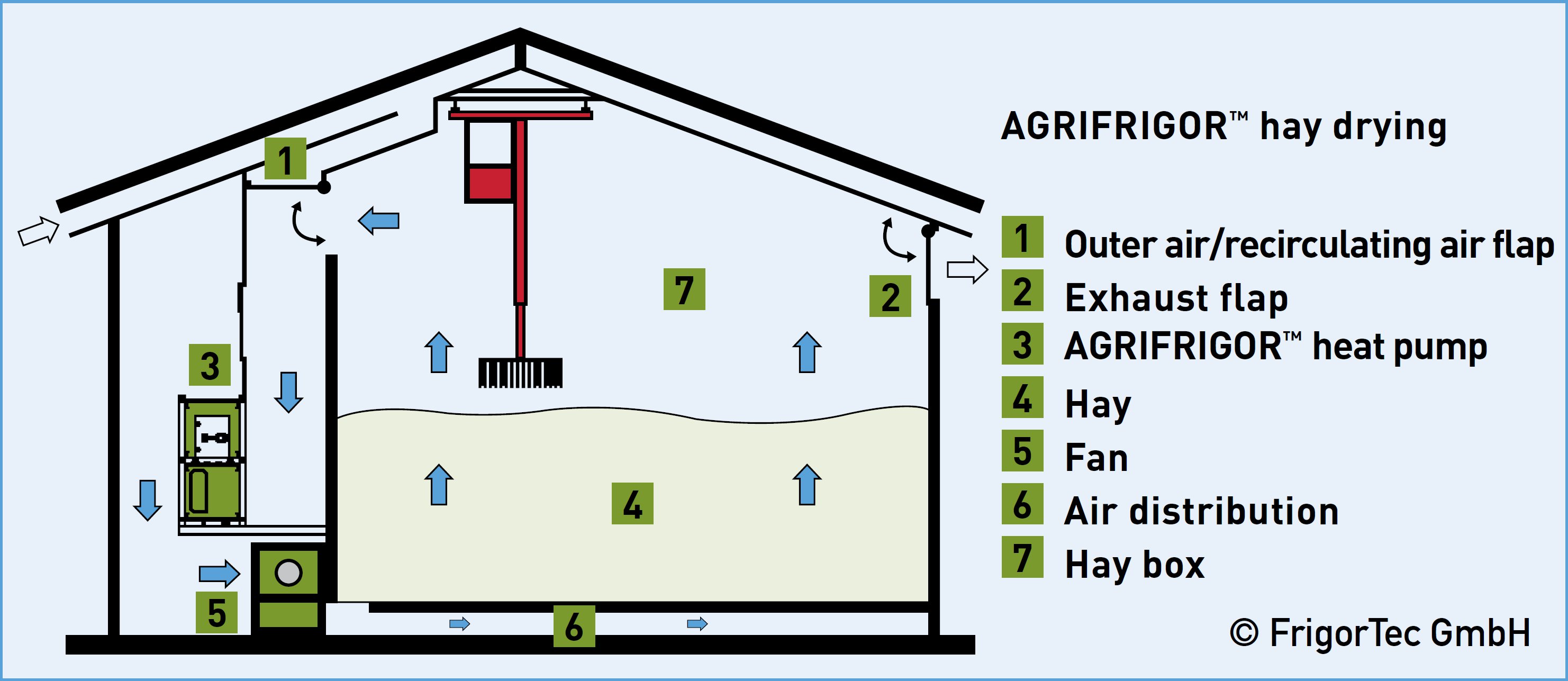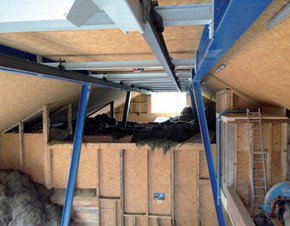Designed to meet requirements as the basis for economical hay drying
Hay drying plants can be integrated into new buildings as well as into existing barns. In order for farmers to fully exploit the advantages of effective and at the same time energy-efficient hay drying, numerous individual factors must be taken into account when designing the plant.
From altitude to personnel resources, numerous parameters are relevant
Every operation has different requirements for hay drying, and every farm has different needs. When designing a hay drying plant, the operating company should therefore sound out a number of parameters, on the basis of which, the correct combination and dimensioning of plant components can be determined. Important are the size and quality of the grassland area, for example. Depending on the region, pasture land also has different yields: Around Lake Constance, for example, up to seven cuts per year can be harvested, while in South Tyrol, which is 1,500 m above sea level, only two to three are possible. The altitude of the location and its climatic conditions determine not only the quality of the hay, but also the components needed to prepare the outside air for hay drying.
The conditions on the farm should also be considered when planning technical hay drying. These include existing buildings, farm logistics, the power supply and the type of energy available (e.g., from a biogas plant). Further influencing factors are the type of livestock and the number of units to be fed, as well as any organic criteria that must be observed. If the hay is fed to dairy cattle, consideration must be taken if the hay milk is destined for cheese production. Other resources of the farm, such as personnel capacities and the available harvesting equipment (e.g. loading vehicles), also play a role in the design of a hay drying plant.
A controller provides an overview if many hay boxes are used
A hay drying plant should be designed so that it can be supplied with both circulating air and outside air. Normally, the plant is operated with outside air. In the case of low temperatures or humid weather, the plant switches to circulating air mode by closing and opening circulating air flaps. As the circulating air has already absorbed moisture from the hay, a dehumidifier is essential for safe circulating air operation. Mixed operation of outside air and circulating air is also possible. Old barns are not always airtight – if the hay drying plant is retrofitted into an existing building, mixed operation often occurs automatically.

Figure 1: Schematic diagram of technical hay drying.
The air flaps can be designed for manual switching or automatic control. In this case, moisture and temperature sensors determine values on the basis of which drives are activated on the air flaps. An additional control unit can display all the switching operations and the plant status centrally on a screen, and transmit data via a modem. Especially when drying hay in several drying boxes, a controller provides operating companies with a comfortable overview.
Reduce energy needs through the heat of the sun
Heat pumps are particularly suitable for technical hay drying thanks to their high performance coefficients. They take on two work steps: The humidity condenses on their evaporator, while at the same time they heat the air. In addition to a high-performance heat pump, careful planning means that other factors can be used to reduce the energy consumption of the hay drying plant. For example, the sunlight on the barn roof can be used for hay drying with the help of solar under-roof preheating. About 300 W of energy can be obtained per square metre of roof surface. This reduces the energy costs accordingly. The possibility of solar under-roof preheating should therefore always be discussed in the planning phase.

Figure 2: Hay boxes with exhaust vent.
When planning the size of hay boxes, use several small boxes instead of one large-volume box. For meadow grass, this means: A ground area of min. 10 m2 and a box volume of min. 30 m3 is advisable for each harvested hectare. Freshly harvested hay should not be stacked higher than 3 m.
Design air ducts and exhaust air openings to be sufficiently large
The even distribution of dry air is a basic requirement for technical hay drying. To this end, take into account the laws of flow dynamics with regard to the respective structural features. The supply air duct must be dimensioned large enough for the pressure loss to remain low, and for the dry air to enter the hay at a sufficiently high pressure. The required pressure also depends on the type of hay stored. Take this into account during planning. Leafy meadow hay, for example, leads to relatively high pressure losses and requires correspondingly powerful fans. For hay drying plants, fans should be designed for 100 to 240 Pa per meter haystack height. The air speed should be on average 0.11 m3/s per square metre of hay box floor area. For an even air inlet into the hay, we advise laying the floor grate at right angles to the flow direction.

Figure 3: Exhaust vent.
To ensure that the exhaust air can flow out of the building unhindered, ensure there are enough sufficiently large outgoing air flaps in new or existing buildings, in which a hay drying plant is to be retrofitted. The accumulation of humid air in the building due to small exhaust air openings can be dangerous not only for the hay, but also for the hay barn. These barns are often made of wood, so condensation must be avoided. Otherwise the building fabric may be damaged. Regardless of whether operating companies are planning a new building for hay drying, or wish to integrate a hay drying plant into an existing barn: If designed carefully, dehumidifier, fan, hay box, under-roof preheating, controller, reheating and air conduction (e.g. outgoing air flaps), can be coordinated so that farmers profit from the most economical solution.
Our products
More know-how articles
Technical hay drying and its advantages
Better planning and quality assurance, more flexibility, independence from weather conditions, less risk of fire, and increased profitability: There are numerous reasons why farmers and operating companies invest in ultra-modern technical hay drying plants, with heat pump, and air dehumidifier.
Quality in quantity – professional hay and plant drying
Good hay quality is no coincidence, rather it comes from making the right decisions. There are clear definitions and guidelines that go into evaluating hay quality. We cannot influence weather conditions, so the use of a technical hay drying plant is nowadays indispensable for a high quality hay yield.
How hay quality affects animal health
Anyone who keeps farm animals knows the relationship between good hay and general animal health. Good hay stimulates ruminant animals, e.g., cows and goats to ruminate. It promotes grazing behaviour with the rumen, prevents metabolic diseases, and has a positive effect on milk yield and quality.
Arrange a consultation appointment
Our experts will be happy to advise you on the planning and implementation of your projects. Together we will find a perfect customised solution.
Arrange an appointment